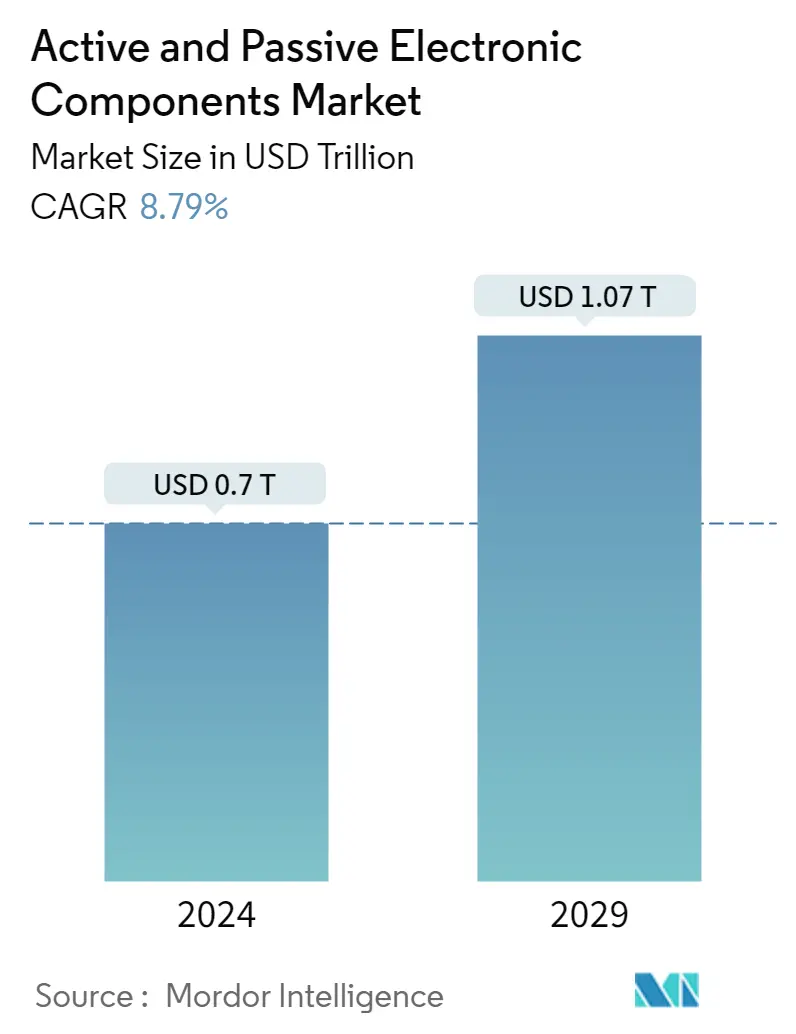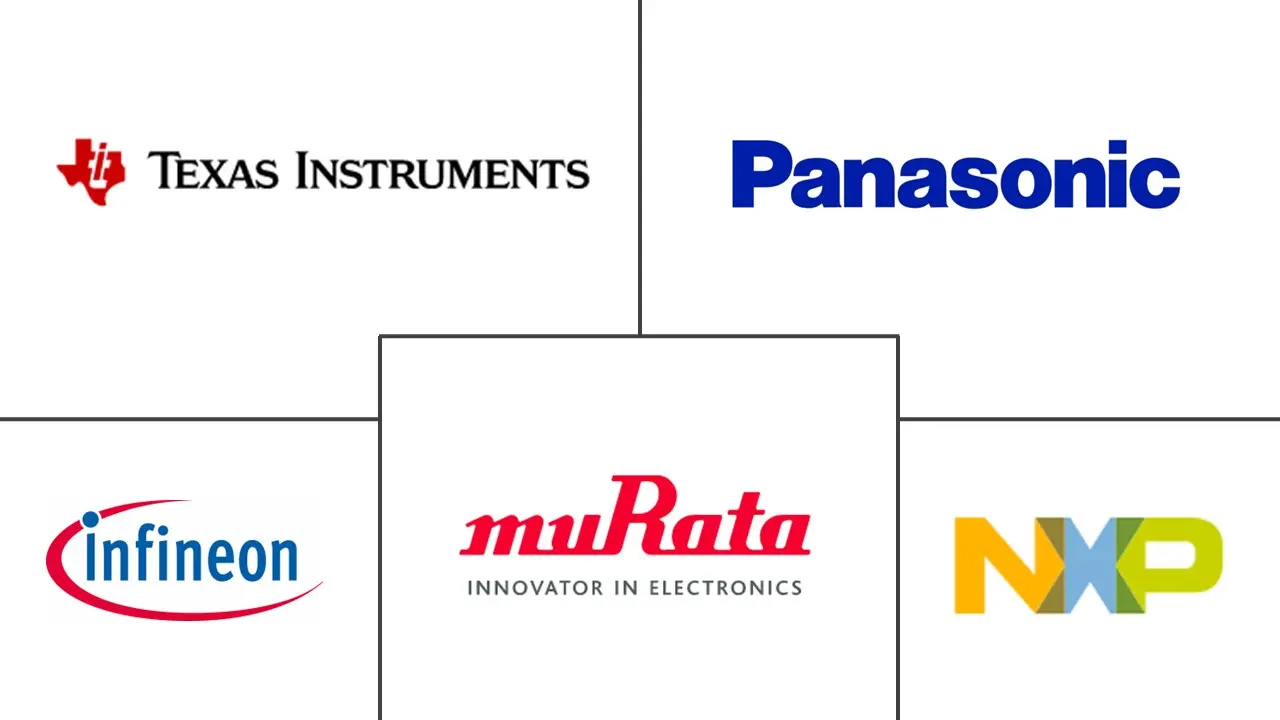Market Size of Active and Passive Electronic Components Industry

| Study Period | 2019 - 2029 |
| Market Size (2024) | USD 0.70 Trillion |
| Market Size (2029) | USD 1.07 Trillion |
| CAGR (2024 - 2029) | 8.79 % |
| Fastest Growing Market | Asia-Pacific |
| Largest Market | Asia-Pacific |
Major Players
*Disclaimer: Major Players sorted in no particular order |
Need a report that reflects how COVID-19 has impacted this market and its growth?
Active & Passive Electronic Components Market Analysis
The Active and Passive Electronic Components Market size is estimated at USD 0.7 trillion in 2024, and is expected to reach USD 1.07 trillion by 2029, growing at a CAGR of 8.79% during the forecast period (2024-2029).
Active and passive electronic components are any semiconductor/electronic device's building blocks. With their simple functionalities, these components play a crucial role in powering an electronic system. While active components are part of an electronic circuit that relies on an external power source to modify/control electrical signals, passive electronic components do not need an external power source to function. They use other properties to control the electrical signal.
- The active and passive electronics market witnessed significant growth over the past few years, primarily due to the increasing digitalization of various sectors. This resulted in the growing adoption of consumer electronics across sectors and the rising need for connectivity and mobility. With these developments, the complexity of electronic products also increased. This accelerated the need for components, especially in the automotive and consumer electronics industries.
- One of the current trends in the consumer electronics industry is the growing demand and need for smaller, lighter, and higher-performing electronics, i.e., the miniaturization of electronics and components. Rapid technological advances have led to the availability of products that incorporate multiple features on a single platform.
- The consumer electronics industry is among the major consumer of active and passive electronic components. These components are among the fundamental building blocks of the circuitry in devices such as computers, cell phones, and several other electronic devices. For instance, a transistor performs various functions such as amplification, voltage regulation, switching, signal modulation, and oscillators.
- The raw materials prices, such as silicon, iron, nickel, and molybdenum, have recently seen significant changes. With the pandemic's influence, the global precious metal market is further witnessing adverse effects of supply chain issues, which also impact the market prices. This increase in the price of palladium, nickel, and ruthenium impacts the overall cost of production for specific large-volume components, challenging the market's growth.
- During the COVID-19 pandemic, the demand for active and passive components increased significantly across the medical and healthcare sector to speed up the detection and treatment process as well as to enhance remote patient monitoring capabilities; healthcare institutions significantly invested in advanced electronic devices, which in turn drove the demand for components such as transistors, capacitors, amplifiers, etc.
- For instance, the demand for electrochemical transistors with a modular architecture witnessed a notable increase in use in sensing devices for the rapid quantification of single-molecule-to-nanomolar levels of specific antigens in complex bodily fluids. Furthermore, various use cases of laser-induced graphene field-effect transistors (LIG-FET) for detecting SARS-CoV-2 were also observed during the COVID period. With these components proving beneficial, further technological innovations are expected to open new growth opportunities in the post-COVID-19 period.
Active & Passive Electronic Components Industry Segmentation
Active electronic components refer to the components that require an external and conditional source to operate in a circuit. Integrated circuits, transistors, and diodes are some of the active electronic components. Passive electronic components are made up of capacitors, resistors, and inductors/magnetics. These components do not require any external source to operate in the circuit.
The study tracks various types of active and passive electronic components. Active components cover transistors, diodes, ICs, amplifiers, and vacuum tubes, while passive equipment includes capacitors, inductors, and resistors. The applications and demand across various end-user industries, such as automotive, consumer electronics and computing, Industrial, and communications, among others, are considered. The revenue generated from the sales of active and passive components is considered to arrive at the market size. Moreover, the report covers key regions, such as North America, Europe, Asia Pacific, Latin America, and the Middle East & Africa. Further, the market study also focuses on the impact of the COVID-19 pandemic on the market ecosystem. The market sizes and forecasts are provided in terms of value in USD billion for all the above segments.
| By Component | |||||||
| |||||||
|
| By End-user Industry | |
| Automotive | |
| Consumer Electronics and Computing | |
| Medical | |
| Industrial | |
| Communications | |
| Other End-user Industries |
| By Geography | |
| North America | |
| Europe | |
| Asia Pacific | |
| Latin America | |
| Middle East and Africa |
Active and Passive Electronic Components Market Size Summary
The active and passive electronic components market is poised for substantial growth, driven by the increasing digitalization across various sectors and the rising demand for consumer electronics. These components are essential building blocks for electronic devices, with active components requiring an external power source to function and passive components operating independently. The market's expansion is fueled by the growing complexity of electronic products, particularly in the automotive and consumer electronics industries. The trend towards miniaturization and the integration of multiple features into single platforms are further propelling the demand for these components. Additionally, the COVID-19 pandemic highlighted the critical role of electronic components in the healthcare sector, boosting their demand for advanced medical devices. The advent of 5G technology is expected to significantly impact the market, offering fast and low-latency connectivity that enhances applications across industries such as consumer electronics and automotive.
The market landscape is characterized by the presence of established players and the entry of new companies, which require substantial investments to compete. The competitive environment remains intense, with companies focusing on product innovations and strategic expansions to capture emerging application areas. The Asia Pacific region, particularly China, Japan, Korea, and Taiwan, plays a pivotal role in the market's growth due to its robust electronics manufacturing industry. These countries are home to major global organizations and semiconductor manufacturers, contributing significantly to the market's expansion. The market is also influenced by fluctuations in raw material prices, which impact production costs. Despite these challenges, the market is expected to continue its upward trajectory, supported by technological advancements and the increasing adoption of IoT-connected devices.
Active and Passive Electronic Components Market Size - Table of Contents
-
1. MARKET INSIGHTS
-
1.1 Market Overview
-
1.2 Industry Value Chain Analysis
-
1.3 Industry Attractiveness - Porter Five Forces
-
1.3.1 Bargaining Power of Suppliers
-
1.3.2 Bargaining Power of Consumers
-
1.3.3 Threat of New Entrants
-
1.3.4 Intensity of Competitive Rivalry
-
1.3.5 Threat of Substitutes
-
-
1.4 Impact of COVID-19 on the industry
-
-
2. MARKET SEGMENTATION
-
2.1 By Component
-
2.1.1 Active Components
-
2.1.1.1 Transistors
-
2.1.1.2 Diode
-
2.1.1.3 Integrated Circuits (ICs)
-
2.1.1.4 Amplifiers
-
2.1.1.5 Vacuum Tubes
-
-
2.1.2 Passive Components
-
2.1.2.1 Capacitors
-
2.1.2.2 Inductors
-
2.1.2.3 Resistors
-
-
-
2.2 By End-user Industry
-
2.2.1 Automotive
-
2.2.2 Consumer Electronics and Computing
-
2.2.3 Medical
-
2.2.4 Industrial
-
2.2.5 Communications
-
2.2.6 Other End-user Industries
-
-
2.3 By Geography
-
2.3.1 North America
-
2.3.2 Europe
-
2.3.3 Asia Pacific
-
2.3.4 Latin America
-
2.3.5 Middle East and Africa
-
-
Active and Passive Electronic Components Market Size FAQs
How big is the Active and Passive Electronic Components Market?
The Active and Passive Electronic Components Market size is expected to reach USD 0.70 trillion in 2024 and grow at a CAGR of 8.79% to reach USD 1.07 trillion by 2029.
What is the current Active and Passive Electronic Components Market size?
In 2024, the Active and Passive Electronic Components Market size is expected to reach USD 0.70 trillion.

